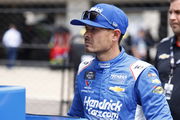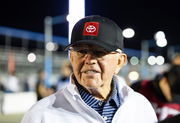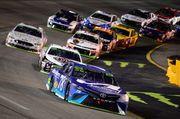

In the racing world, race tracks are often repositories for countless memories, both cheerful and gloomy. Some race tracks stand in testament to the glory of adrenaline-fueled motorsports, while others show its darker and cruel aspect. In October 1954, legendary sportswriter Sandy Grady had something to speak about NASCAR’s first race track to host a race under lights, Raleigh Speedway.
Watch What’s Trending Now!
Sandy wrote, “Drivers know that race tracks are like people. Some have nothing but happy memories, while others have dark, stormy pasts that haunt them. In the latter class falls the Raleigh Speedway.” The September 19, 1953 scenario at the Raleigh Speedway terrified drivers and fans alike for the years to come as a horrific crash shot flames up to a hundred feet in the air, and a trail of shock and horror followed. Since then, Raleigh has never featured on NASCAR’s calendar again.
ADVERTISEMENT
The tale of Black Saturday: A day of horror at the Raleigh Speedway
NASCAR arrived in Raleigh for the National Sportsman Modified stock car championship race on September 19, 1953. Today, we see the Charlotte Motor Speedway hog the limelight when it comes to a discussion of race tracks in North Carolina. While the track was considered an advanced superspeedway and was ahead of its time, it didn’t comply with the safety standards that are the norm today.
As the 220-mile, 60-car race began, Bill Blevins’s Ford encountered a mechanical fault and did not start. A push truck helped him get the needed push-start. However, his car stopped again at the exit of turn two on the backstretch. This incident wasn’t noticed by the race authorities as the race continued with the waving of the green flag.
The arena was jam-packed, and the audience erupted to alert the flagman about an impending danger. However, it was too late. The rest of the 59-car grid arrived at turn two at full speed. One of the cars collided head-on with Blevins’ Ford, triggering a multi-car wreck. But the horror was yet to unfold.
ADVERTISEMENT
Jesse Midkiff drove the car that bumped into Blevins’s. A chain reaction of tragic events ensued after a fire broke out in Blevins’ car. Safety workers rushed to the site to extinguish the flames, but the situation could not be controlled, with only two fire extinguishers at their disposal. The flames rose to a hundred feet, and the officials failed to get the drivers out of the car.
Blevins and Midkiff were instantly killed, as the audience watched in shock and horror. The flames threw debris all around the track and injured several other drivers. More than 15 cars suffered intensive damage, and the race was shortened by 50 miles. An 80-minute-long caution period followed the incident, and officials got to work to clear the race track.
ADVERTISEMENT
That was the story of one of the most terrible races in NASCAR’s history. While the Raleigh Speedway continued to attract hordes of fans, it was eventually shut down in the late 1950s. Initially built on the outskirts of Raleigh city, urbanization brought housing and the public closer to the race track. As the complaints about noise pollution, the risk of accidents, and increasing crowds in the area rose, the Raleigh Speedway experienced a slow death. It never recovered.
Watch This Story: Kyle Larson opens up charters for High Limit Racing, doing what NASCAR couldn’t
What was more surprising is that the speedway had gone bankrupt in 1953 and made a comeback under the name of Dixieland Speedway. As the NASCAR fever gripped the speedway’s attention, it was renamed Raleigh Speedway. While to some, it might have seemed like the start of the story of NASCAR’s most advanced race track, the Black Saturday crash changed the course of history.
ADVERTISEMENT
Top Stories
Kyle Larson Loses $33,000 in Australia Moments After Winning $110,000 Briefcase at Perth

Coach Gibbs Pulls the Trigger on Massive JGR Sale, Triggering $25M Shake-Up in Charlotte

NASCAR Signals Its Patriotic Push With a New Name for the Daytona Duels

NASCAR Fans Worried for Denny Hamlin’s Mental State as Tragedy Hits Home

Kyle Busch’s Wife Samantha Gets Divine Sign from God After 15 Years of Marriage

Raleigh turned out to be the end of the road for the first monkey to win a NASCAR race
Some of the biggest names of that NASCAR era had raced at the Raleigh Speedway. From Richard Petty’s father, Lee Petty, to Glen Wood, drivers wanted a taste of North Carolina’s first superspeedway and night racing under the lights. However, one of the peculiar figures to grace the race track was Jocko Flocko, a Rhesus monkey.
NASCAR driver Tim Flock was known for aiding Jocko Flocko and accompanying him during races, and that attracted many people towards what seemed an unnatural twist in the tale. As the legend of Jocko Flocko grew, he earned two famous monikers—”The Fastest Monkey Alive” and “The First Monkey to Win a Race.” Tim Flock often smuggled Jocko into his car so that the officials wouldn’t notice his presence and prevent it from happening.
ADVERTISEMENT
However, in one of the races at the Raleigh Speedway, Jocko Flocko experienced his last ride in a car. In a bizarre incident, Jocko managed to open a small hatch on the car all by himself as he pulled a cord mistakenly. Drivers used the hatch to keep track of the tire’s durability during a race. But for some reason, Jocko Flocko was scarred by his deeds and shrieked with fear inside the car. As he began to act strangely and clawed Tim Flock in the face, the driver had no other option but to leave him with his pit crew.
Jocko Flocko’s curiosity for racing ended that day at the Raleigh Speedway, and he was never seen at a race track again. Unfortunately, he remained in trauma after that fateful day, refusing to eat. Soon after, it was decided to put him down and the life of The Fastest Monkey Alive came to an end.
The Raleigh Speedway has housed numerous cases of misfortune as a race track. Though it was designed to lead NASCAR into a new age of racing, sadly, it couldn’t be a part of the new era.
ADVERTISEMENT
ADVERTISEMENT
ADVERTISEMENT
ADVERTISEMENT

